Is the Anova Precision Oven worth it? It’s much more than a steam oven. This first-to-market countertop combi oven for home cooks is not perfect, but it’s far better than any of the alternatives—making it the best countertop oven I’ve ever used.
Sizzle and Sear Kitchen Equipment Deal Alerts In Your Inbox
Quick Summary
Pros for the Anova Precision Oven
- As precise as you will get for a counter top oven, allowing you to sous vide without a bag!
- Actual temperature of oven chamber read out on user interface.
- Very roomy cooking chamber with extra headroom for a large dutch oven.
- Much more affordable than any other combi oven on the market.
Cons for the Anova Precision Oven
- Drip tray difficult to remove.
- Plastic tank, metal racks, and pan feel flimsy. Replacement stainless steel pans for low-heat cooking and aluminum pans for high-heat cooking available.
- No perforated cooking pan despite the fact that it was featured heavily in the promotional videos for the oven. Luckily a 12" x 17" cooling rack fits perfectly into the side slots of the oven; you can cook on top of it; a perfect alternative to the perforated pan.
- App recipes need better curation (see my experience with the Glazed Salmon recipe below.).
Up Your Sous Vide Game with the Anova Vacuum Chamber Sealer
• Yes, you can sous vide in your Anova Precision Oven, and a vacuum chamber makes it easier than ever!
• A chamber vacuum sealer works differently than edge/suction sealers. Instead of sucking the air out of a bag, the bag is placed in a chamber and the entire chamber is evacuated of oxygen. Once the chamber is evacuated, the bag is sealed and air is let back into the chamber. This results in a much better vacuum and makes vacuum sealing liquids easy.
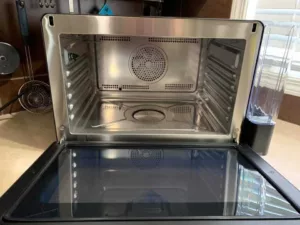
Anova Precision Oven Accessories and Pans
Need a perforated pan for your Anova Precision Oven? Or more cookware in order to fully take advantage of the oven? Check out our recommendations.
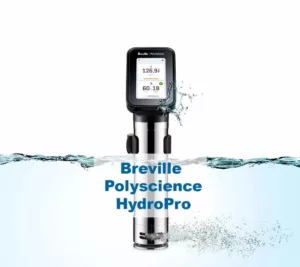
Breville Polyscience HydroPro Plus: The Best Sous Vide Immersion Circulator?
Immersion circulators and sous vide have become incredibly popular, but there hasn’t been much innovation in the market in recent years; until now.
Anova Precision Oven Review
Last month, Anova, popular for manufacturing sous vide immersion circulators, released its precision oven. Anova describes their oven as “the first combi-oven with pro-level features for the home cook.” Anyone who is familiar with combi-ovens know that if this claim is true, the oven is well worth the $599 USD Anova is asking for it; in fact, it may well be the best countertop oven on the market.
I ordered an Anova Precision Oven in order to test the manufacturer’s claims. I’ve been using the precision oven for about a month now; I’ve cooked a variety of foods in it, and I’m ready to share my experience with it.
What is a Combi Oven?
A combi-oven is a versatile oven that can do everything a conventional or convection oven can do; plus it can steam, control the relative humidity of the cooking chamber, sous vide, and maintain temperatures accurately and precisely. These ovens are mostly found in professional kitchens and cost thousands of dollars.
Combi ovens inject and precisely control moisture in their cooking chambers through steam. They allow you to set the relative humidity of the cooking chamber, which helps controls the wet-bulb temperature (the actual temperature your food is experiencing in the oven). As a result, combi-ovens allow for incredible temperature control, which lets you do cool things, like “sous vide without a bag”. If you prefer to use a bag to trap in volatile aromatics (e.g. fresh oregano or thyme), there is nothing stopping you from using vacuum sealed bag and sous viding the “traditional” way in this oven.
Comparing the Anova Precision Oven to other Steam and Non-Steam Counter Top Ovens
Several years ago, after reading Modernist Cuisine at Home, which dedicates two pages to combi-ovens, I wanted to experiment with this method of cooking and baking. However, there were no countertop combi ovens on the market, and if I wanted to replace my conventional oven with a combi-oven, it would end up costing me tens of thousands of dollars. When Cuisinart released its combo steam and convection oven , I purchased it as a way to experiment with steam cooking. For just a few hundred dollars, I didn’t think I had much to lose; plus, I didn’t own a countertop oven at the time, and I knew I could put it to use even if it wasn’t a true combi-oven.
The Cuisinart is fine for foods where you want to cook with a little bit of steam, but it has some serious limitations. First of all, the size of the water reservoir is significantly smaller than the Anova Precision Oven’s water reservoir. For most everyday tasks, the Cuisinart’s water tank is enough, but if you want to slow cook ribs for 8 hours, you’ll find yourself wanting to replenish the water in the tank often. Furthermore, you have to remove the Cuisinart’s water tank if you want to add more water, while the Anova Precision Oven allows you to add water from the top without removing the tank during a long cook.
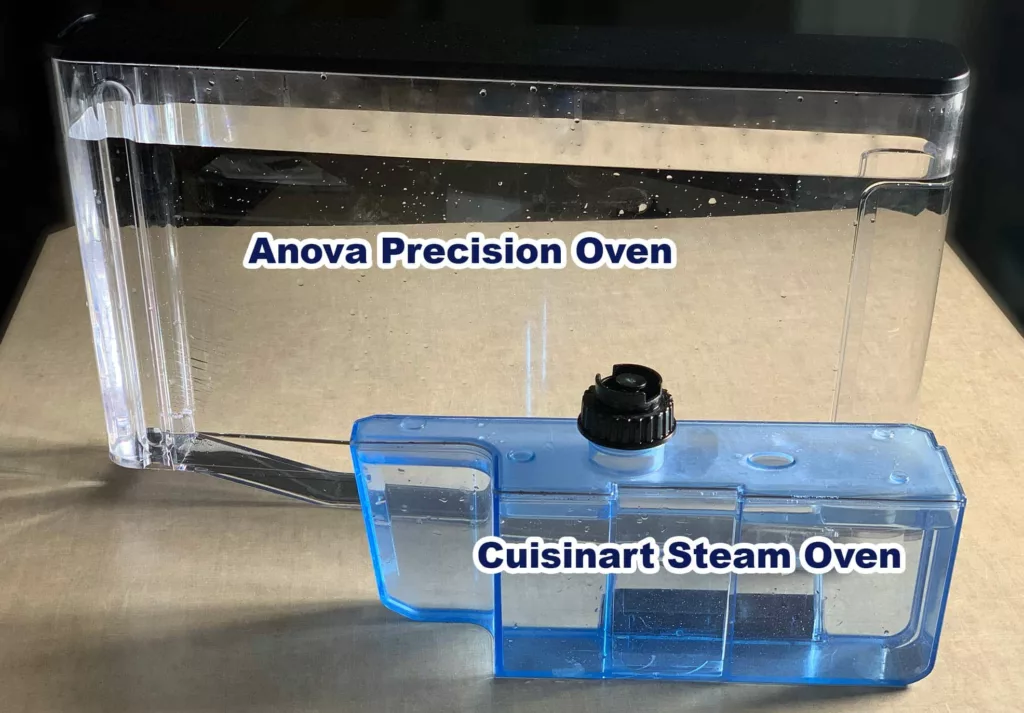
Another downside of the Cuisinart combo steam and convection oven is that it can only be controlled in increments of 10 degrees Fahrenheit, and like most other ovens, the user interface will read out the set temperature instead of the actual temperature. This contrasts with the Anova Precision Oven, which allows you to control the temperature to a fraction of a degree using its app (1 degree increments using the physical interface) and the oven will read out the actual temperature inside, not just the set temperature.
Anova promises an accuracy of +/- 0.5°F when in sous vide mode (+/- 6°F at high temperatures outside of sous vide mode); my testing has shown that this is achieved after the oven stabilizes at its set temperature, with very little overshoot before stabilizing. This gives you the confidence to sous vide at lower temperatures without worrying about entering the danger zone, where microbes multiply and grow, or overcooking your meal due to frequent and significant temperature swings and overshooting. And I haven’t even mentioned the food temperature probe that comes with the Anova that allows you to monitor the temperature of your foods and to program cook stages that change when certain temperatures are reached.
Lastly, the Cuisinart steam oven is much smaller than the Anova Precision Oven; while this may be a benefit for small kitchens, you are seriously limited in the types of foods you can cook in the Cuisinart steam oven where you have a lot of freedom with the Anova Precision Oven.
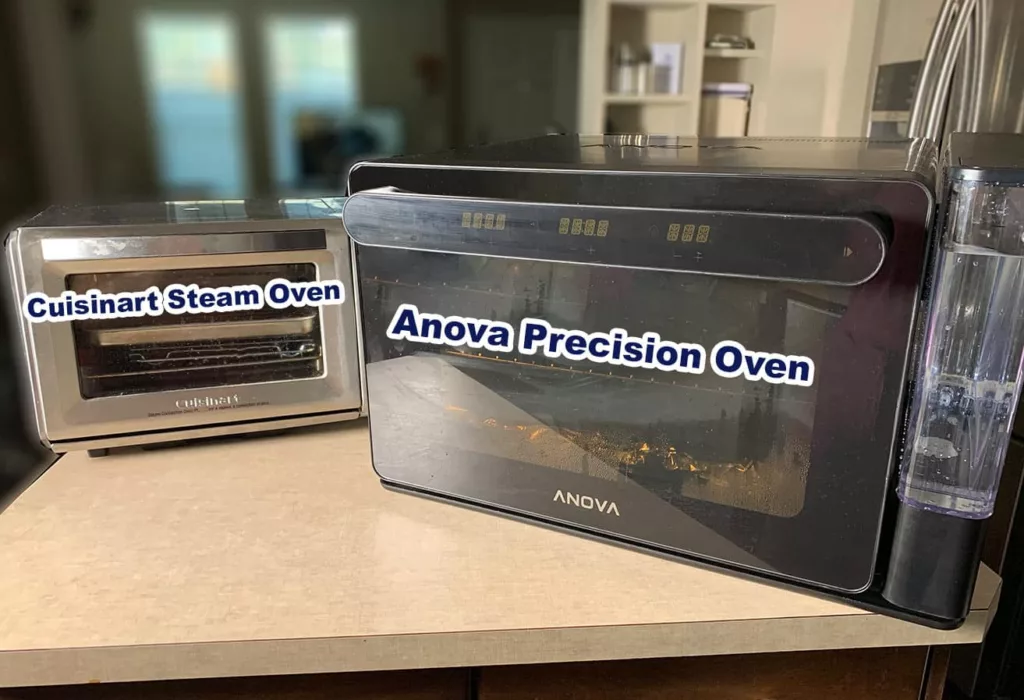
I’d like to also compare the Anova Precision Oven to one more popular counter top oven. A few years ago, I was living in a basement suite when I had to relocate to a new province in my first year of teaching. The basement suite had a small kitchenette. My Cuisinart steam oven did an okay job, but I wanted to upgrade to a bigger oven in order to have a more versatility for my cooking. I settled on the Breville Smart Oven Air with super convection , which is an all around great oven, but it of course is missing the ability to inject steam into the oven chamber and to precisely control and monitor its temperature. I thought the Breville Smart Oven Air was a huge oven, but then I got the Anova Precision Oven, and it ain’t no toaster oven. The cavity of the two ovens have roughly the same width and depth (the Breville has a small groove in the back to fit a 13-inch pizza pan; while the Anova does not) , but the Anova Precision Oven has significantly more height. When I first purchased the Breville, I had to get a new knob for my 7 1/4 Quart Le Creuset Dutch (French) Oven, in order to squeeze it in the oven. As you can see from the picture below, I can easily fit the Le Creuset into the oven with the original knob with lots of space to spare! With the precise low temperature control of the Anova, I essentially have a precision slow cooker!
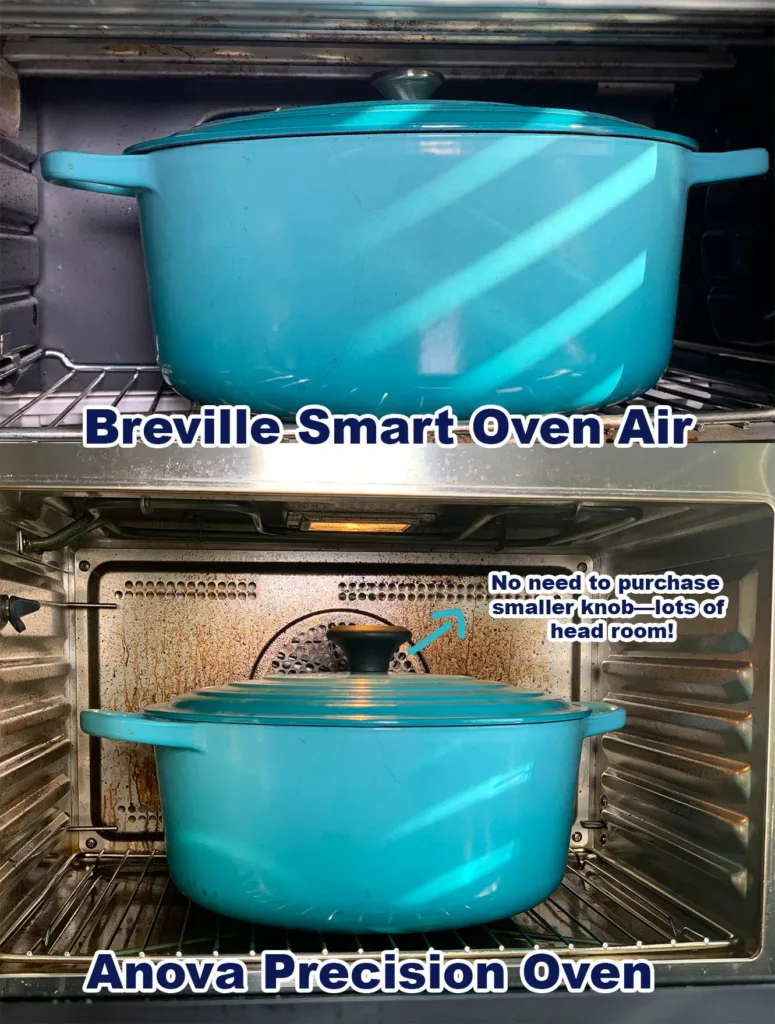
Cooking with the Anova Precision Oven
So far I’ve cooked lots in the Anova oven and have been pleasantly surprised with the results. I’ve roasted chicken and potatoes, steamed Brussels sprouts and salmon, and steam broiled a whole head of cauliflower in the oven.
Roast Chicken using the Anova Precision Oven
I made a whole chicken by following the recipe contained in the Anova iPhone app (also available on Android). The recipe calls for a spatchcocked chicken to be dry cooked (0% humidity) on a perforated pan for 2 hours at 149°F until the core of the chicken is 145°F. The chicken is then removed from the oven, while the oven is heated at its highest setting and fans are set to their highest speeds. The chicken is quickly crisped and then rested before serving.
I was disappointed that the oven did not come with a perforated pan, despite it being featured heavily in many of the videos that were used to promote the oven; however, I found my 12-inch x 17-inch cooling rack slid perfectly into the slots of the oven. The chicken was cooked directly on the cooling rack, with a pan on the bottom of the oven to catch any dripping grease.
Pricing last updated on April 26, 2024 - 1:30 MDT. Pricing and images from Amazon Product Advertising API. Product prices and availability are accurate as of the date/time indicated and are subject to change. Any price and availability information displayed on Amazon at the time of purchase will apply to the purchase of this product.
A chicken cooked for 2 hours at 149°F until the core of the chicken is precisely 145°F; finished in the Anova Precision Oven at high heat and high fan speed
I was a bit alarmed when I saw the low temperature; I had never cooked a chicken at such a low temperature in an oven! But I knew from my experience sous viding that this was well within the pasteurization zone; the only question was whether or not the final high-heat stage would be enough to make the chicken palatable.
I’ve got to say I’ve never seen a chicken hold onto so many of its juices! When I first removed the chicken from the oven, I noticed the skin was crispy and bulging in areas, and I could literally squish around the liquids underneath the bubbles in the skin. Lots came pouring out as I carved the bird, and they were all running clear.
The chicken was cooked perfectly, and it was the juiciest i’ve ever had. I’m not 100% sure if I prefer this roasted chicken over a traditional roasted chicken, but I don’t think it’s fair to compare. They really are two completely different dishes, and I can see myself wanting either one depending on my cravings.
Quick Steamed and Buttered Brussels Sprouts using the Anova Precision Oven
As a side to the chicken, I steamed some Brussels sprouts from the garden for 10 minutes at 212°F with 100% humidity. Before placing the Brussels sprouts into the oven, I threw in two knobs of butter, salt, and pepper inside the pan. This was an easy to prepare side dish that cooked while the chicken was resting.
Glazed Salmon Cooked in the Anova Steam Oven
This recipe also came from the Anova app. Following the directions in the app, the recipe took a long time to get up to temperature; in fact, it never got up to temperature. However, this is because of an error in the recipe. The recipe had the oven set at 130°F (100% humidity) and a probe inside the salmon that was set at 130°F. The final steps of reaching true equilibrium in an oven environment is always going to take a long time. I ended up pulling the salmon from the oven when it was around 127°F, but I will experiment in the future with an oven temperature of around 133-135°F in order to achieve a core temperature of 130°F. Luckily the salmon was still salvageable, as later stages in the recipe required quick 1 minute cooks in a 400°F oven in order to caramelize and bake on a glaze; which brought the core temperature of the salmon up to the 130°F target.
The salmon was perfectly cooked, and the glaze was very tasty! I had some left overs and was able to reheat them the next day at 135°F (100% humidity). The salmon was even more tasty the next day!
Whole Roasted (and Steamed) Cauliflower in the Anova Combi Oven
This is a recipe by Scott Heimendinger that can be found in the Anova app. It is simple but delicious! Simply coat a whole cauliflower (core and leaves removed) with olive oil, and season it with your choice of spices. Steam at 100% humidity in a 356°F for 25 minutes; remove from oven and heat oven to 482°F ; return cauliflower to dry oven (0% humidity) for 10 minutes to get a nice spotty brown surface. Slice and serve like a cake! Some people might say it looks like a burnt sponge, but it’s truly delicious! The simplicity of the dish has guaranteed a spot in my regular side-dish rotation.
One Pan Steamed Rice and Chicken Cooked in the Anova Precision Oven
Included in the app is a steamed chicken and rice dish where you plop all the ingredients, except for the frozen veggies, in one pan and let it steam all at once! Frozen veggies are then added at the very end so that you don’t overcook them.
I really like the idea of cooking a chicken and rice dish in a steam oven all in one pan. It reminds of the Juane, a Peruvian chicken rice dish steamed inside a banana leaf. The recipe provided in the Anova Precision Oven app was a little underwhelming in taste, so I will be adding my own spices and ingredients the next time around. This recipe has a lot of potential and makes chicken and rice an even easier dish than ever!
Where the Anova Precision Oven Truly Shines: Breakfast!
By far my favourite thing to do in the Anova Precision Oven is to cook up some breakfast! You can easily steam up a gourmet omelet in 5 minutes! Or cook up some home fries that are perfectly crisp on the outside but still soft and chewy on the inside!
Bacon cooked in the Anova Precision Oven has a level of chew that I’ve never been able to achieve on the stovetop. Still, I prefer mine a little bit more crispy than the app’s recipe, so I ensure add a couple more minutes on the dry heat stage of the cook.
Lastly, there’s a recipe for “steamed toast”. Yes, you heard that right, “steamed toast”. I was very sceptical of this recipe at first, but I gave it a whirl. This odd sounding recipe resulted in toast that was deliciously crispy on the outside but fluffy and chewy on the inside. It takes several more minutes than a dedicated toaster, but it’s well worth the wait.
Steam Oven vs. Sous Vide: The Anova Oven Can Do Both
Anova markets its oven as being capable of sous viding without a bag. My experience with chicken and salmon prove that this is the case. What is especially useful Is being able to track the internal core temperature of your food with the included probe. This allows you to set the oven temperature slightly above the target temperature, dramatically decreasing the amount of time it takes to cook. The difference between using this technique and traditional sous vide is indiscernible. I also cooked a rib eye steak using the same technique and got amazing results.
The Anova Precision Oven has Room for Improvement
With it’s ability to precisely control the temperature and relative humidity of the cooking environment, the Anova Precision Oven is the best countertop oven for home cooks! It comes at a very affordable price compared to other combi ovens and is large enough to fit a large dutch oven; transforming the oven into a precision slow cooker!
Being the first-to-market countertop combi-oven for home cooks has its challenges though. From a design perspective there are several things that I’m left wanting. First of all, the drip tray at the front that catches excess water is very difficult to remove. You need to place your thumb into a notch on the right side of the oven in order to get a grip; however, that notch is exactly where there is a steam vent, so you’ve got to be extra careful! I’ve yet to remove the drip tray without spilling some water on the counter.
Second, some of the components feel rather flimsy. The water tank’s plastic seems really thin and fragile. I am worried about the weight of the water swooshing around, so I do not recommend moving the oven with a full water tank. The metal rack and pan that comes with oven feel equally flimsy; I wish Anova would have spent a little more effort in sourcing quality accessories. Speaking of accessories, the perforated pan that was featured heavily in promotional videos does not come with the oven. Anova tells me that they expect to sell one separately soon—I will have to keep an out for that.
The light inside the oven seems to persistently flicker; a minor nuisance. A bigger problem though is that I’ve had trouble running a new cook immediately after a recipe is finished. The oven has difficulty maintaining a new temperature so soon after a cook has been completed. I find if I wait for the oven to cool down, then the oven has no problem maintaining the new temperature. Hopefully this is something that a future firmware upgrade could fix.
Finally, the app needs some better curation of recipes. Some of the recipes that I tried needed some tinkering with in order for them to work (e.g. the Glazed Salmon Recipe). While this isn’t a flaw of the hardware, the recipes contained in the app are definitely a selling feature and should be perfected.
Overall, I highly recommend this oven as it is the best countertop oven I’ve ever tried, and it will surely change the way I cook. It has earned a spot next to my prized Breville PolyScience Control Freak induction cooker when it comes to precision cooking.
The Best Pan for the Anova Precision Oven: 5-Ply Solid Construction (Non-Warping), Excellent Heat Distribution, and Easy Cleanup (14" x 10")
Those who cook with triply cookware like All Clad know the benefits of cladded cookware. This sheet pan goes beyond triply with 5 alternating layers of stainless steel and aluminum. This 5-ply sheet pan (14" x 10") from 360 Cookware comes at a premium, but if you want the best this is the way to go. Its 5 alternating layers of stainless steel and aluminum gives you the best of both metals: excellent heat distribution and easy cleanup (it can even go in the dishwasher). The cladding also makes it virtually unwarpable (I've used it in both 482°F and a freezer and it's flat as ever). Read my in-depth review of 360 Cookware here.
$129 $96.75 (with checkout coupon code: SizzleAndSear25)
Pricing last updated on April 26, 2024 - 1:24 MDT. Pricing and images from Amazon Product Advertising API. Product prices and availability are accurate as of the date/time indicated and are subject to change. Any price and availability information displayed on Amazon at the time of purchase will apply to the purchase of this product.
Pricing last updated on April 26, 2024 - 1:24 MDT. Pricing and images from Amazon Product Advertising API. Product prices and availability are accurate as of the date/time indicated and are subject to change. Any price and availability information displayed on Amazon at the time of purchase will apply to the purchase of this product.
Pros for the Anova Steam Oven
- As precise as you will get for a counter top oven, allowing you to sous vide without a bag!
- Actual temperature of oven chamber read out on user interface.
- Includes temperature probe that can be used to program staged cooking.
- Very roomy cooking chamber with extra headroom for a large dutch oven.
- Great for reheating left overs.
- Perfect for omelettes and egg-based custards
- Upgradable firmware!
- Can effectively be used with, or without, an app
- Much more affordable than any other combi oven on the market.
Cons for the Anova Steam Oven
- Drip tray difficult to remove.
- Plastic tank, metal racks, and pan feel flimsy. Replacement stainless steel pans for low-heat cooking and aluminum pans for high-heat cooking available.
- Some difficulty maintaining temperature when you switch to a new recipe immediately after a cook.
- Flickering light.
- No perforated cooking pan despite the fact that it was featured heavily in the promotional videos for the oven. Luckily a 12" x 17" cooling rack fits perfectly into the side slots of the oven; you can cook on top of it; a perfect alternative to the perforated pan.
- App recipes need better curation (see my experience with the Glazed Salmon recipe above.)
I hope you enjoyed my review of the Anova combi oven. Please feel free to ask any questions in the comments below.
Interested in a high quality commercial immersion circulator for sous vide cooking? Check out the Breville Polyscience Hydro Pro plus.

Anova Precision Oven Accessories and Pans
Need a perforated pan for your Anova Precision Oven? Or more cookware in order to fully take advantage of the oven? Check out our recommendations.

Breville Polyscience HydroPro Plus: The Best Sous Vide Immersion Circulator?
Immersion circulators and sous vide have become incredibly popular, but there hasn’t been much innovation in the market in recent years; until now.
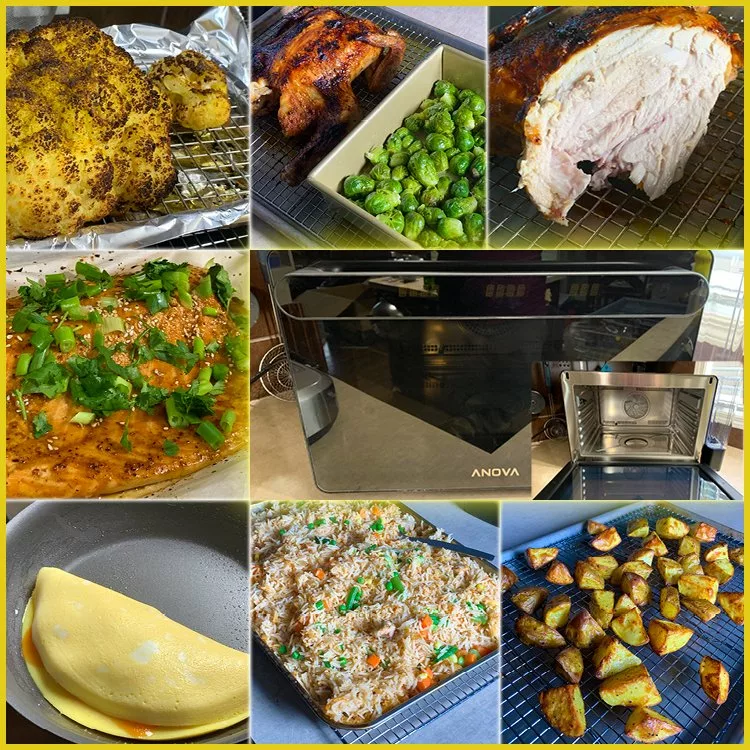
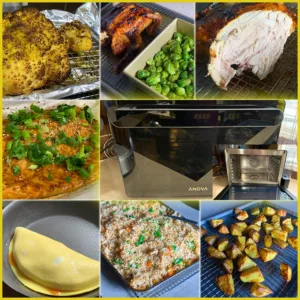

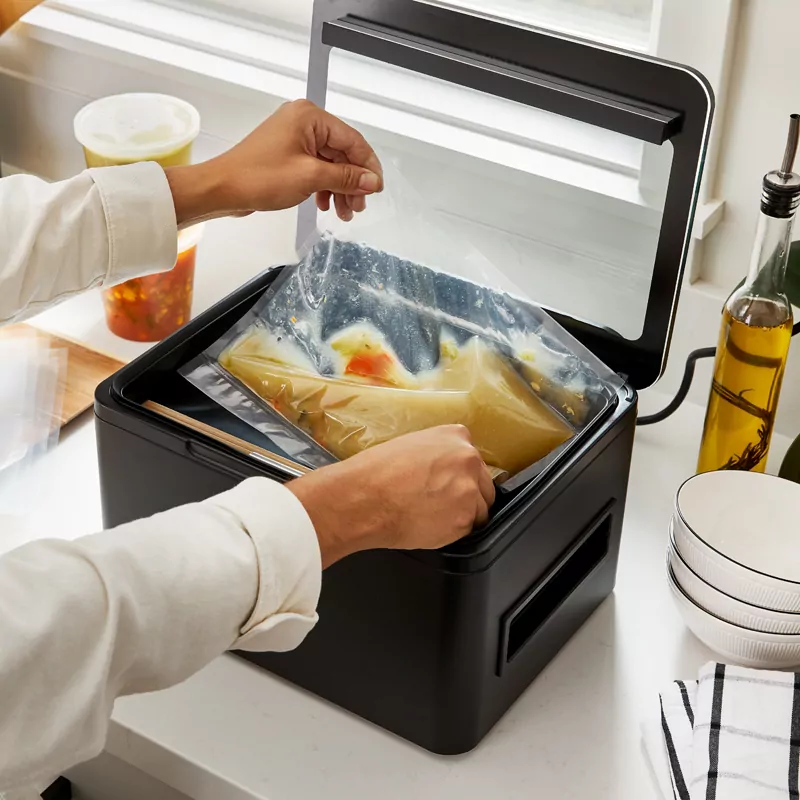
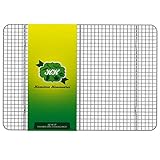
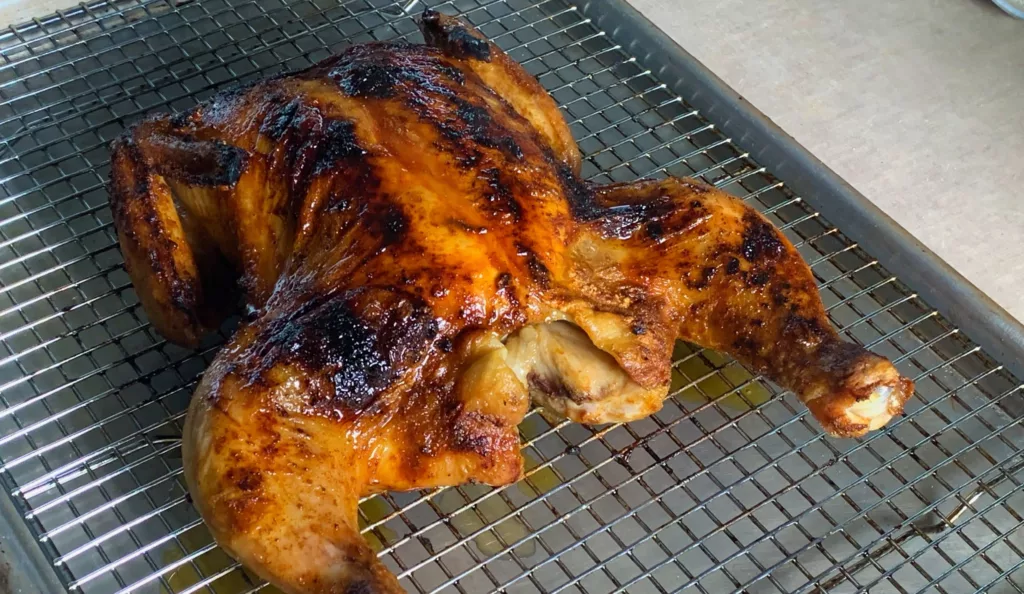
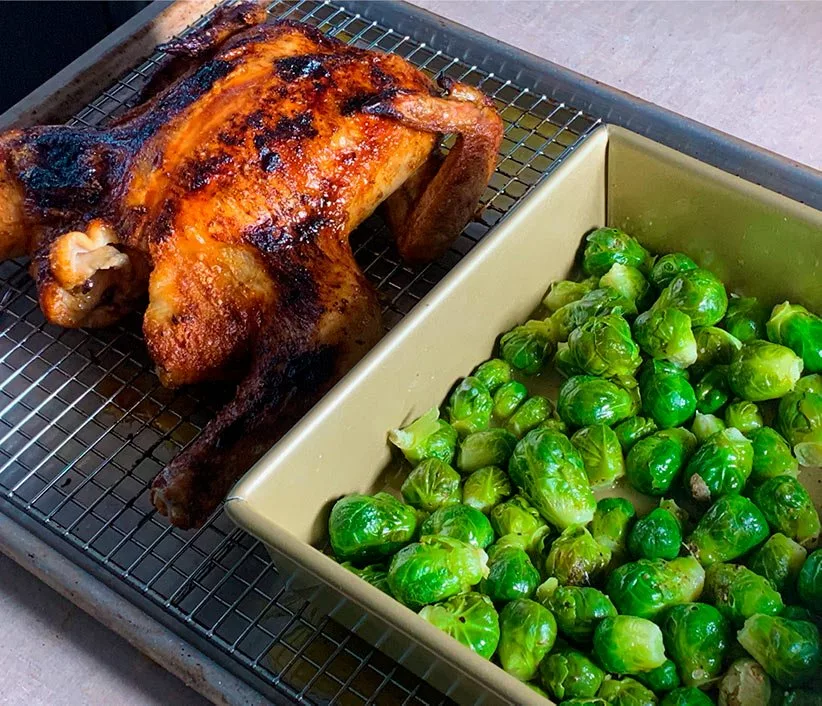
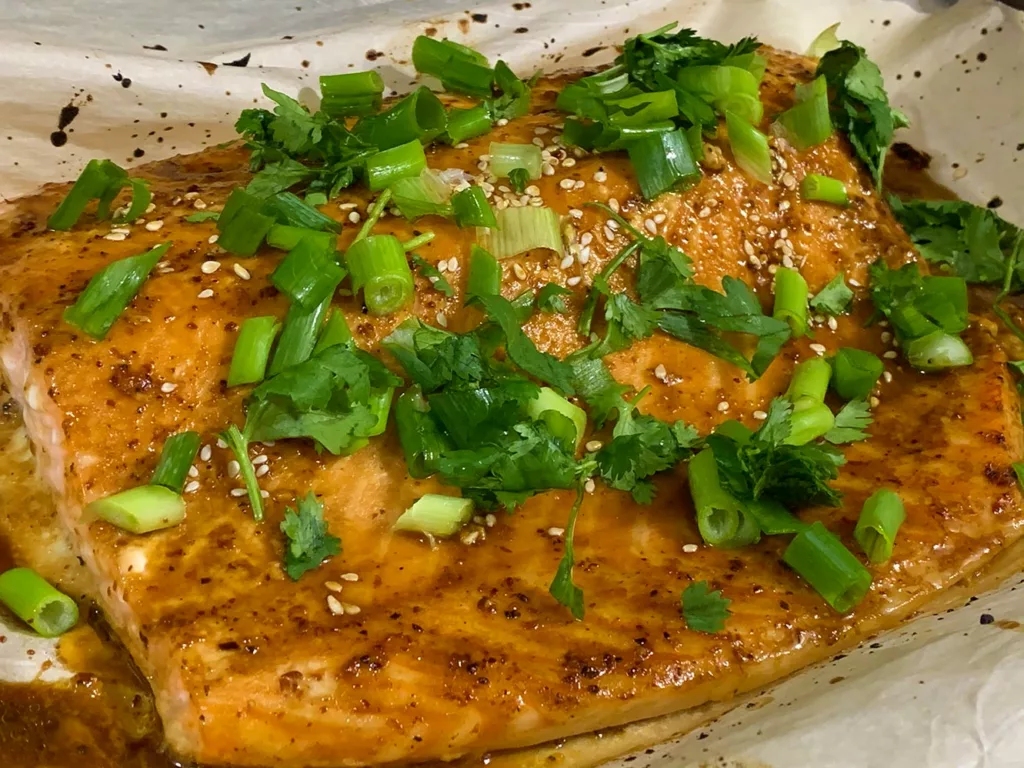
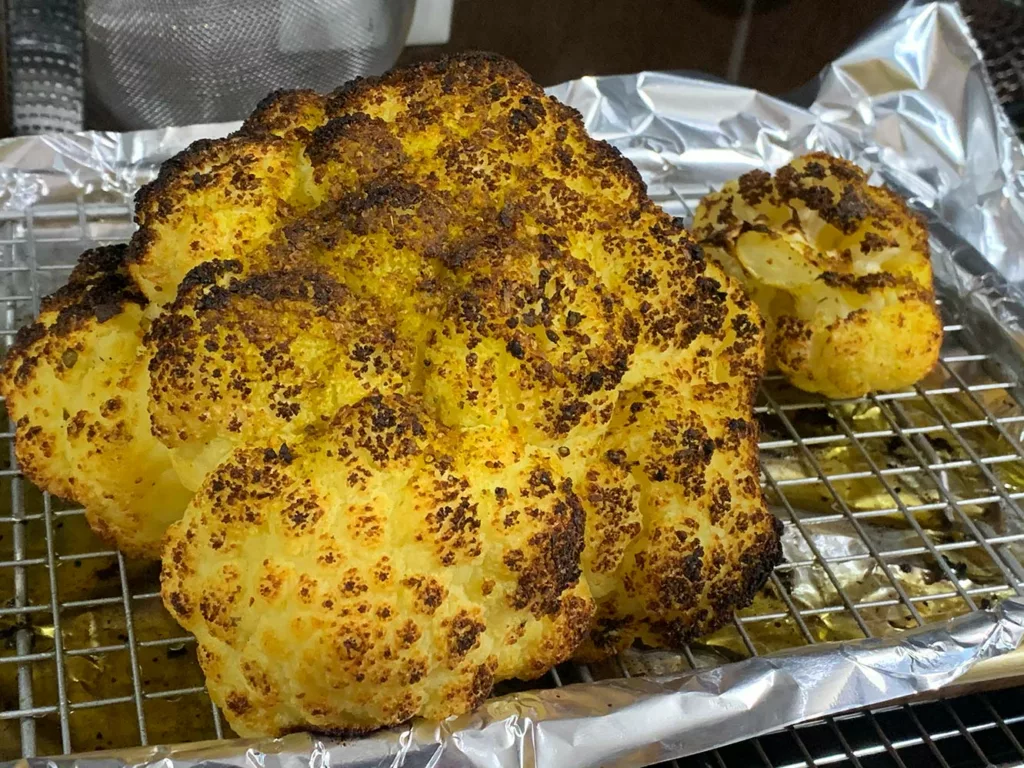
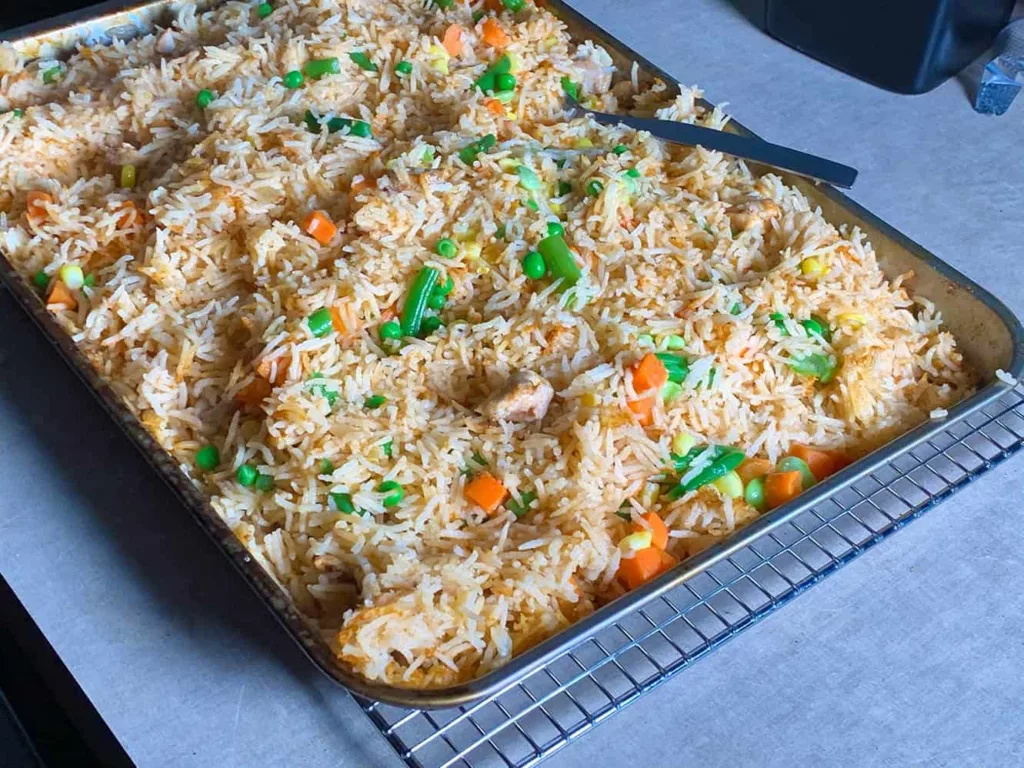
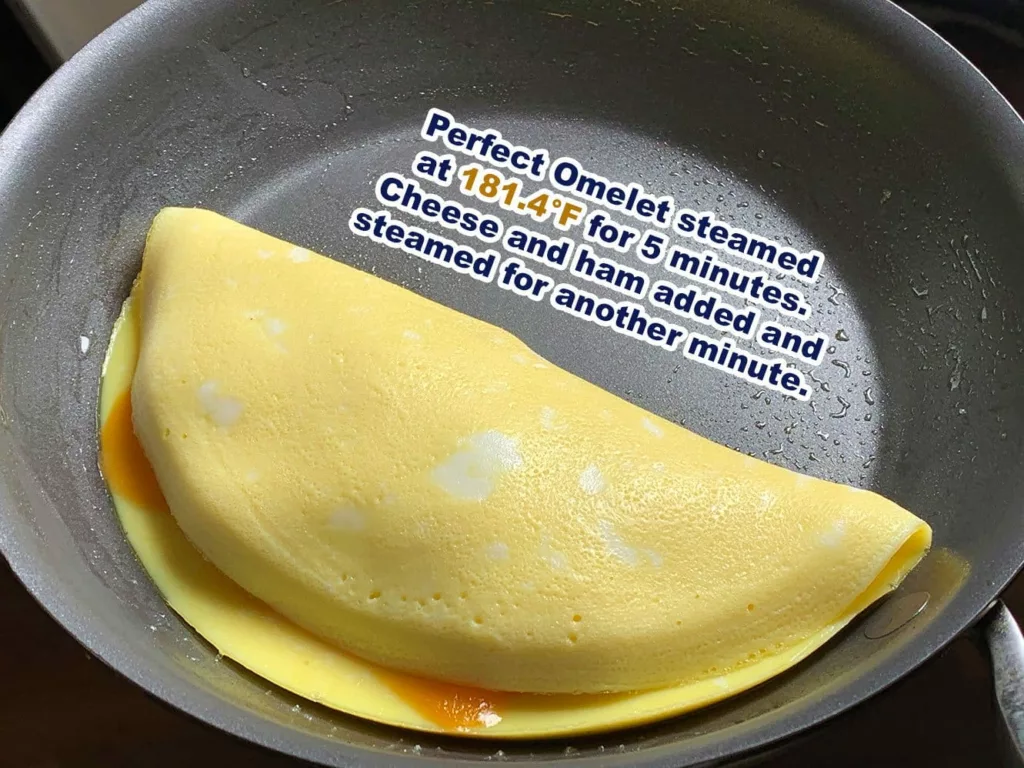
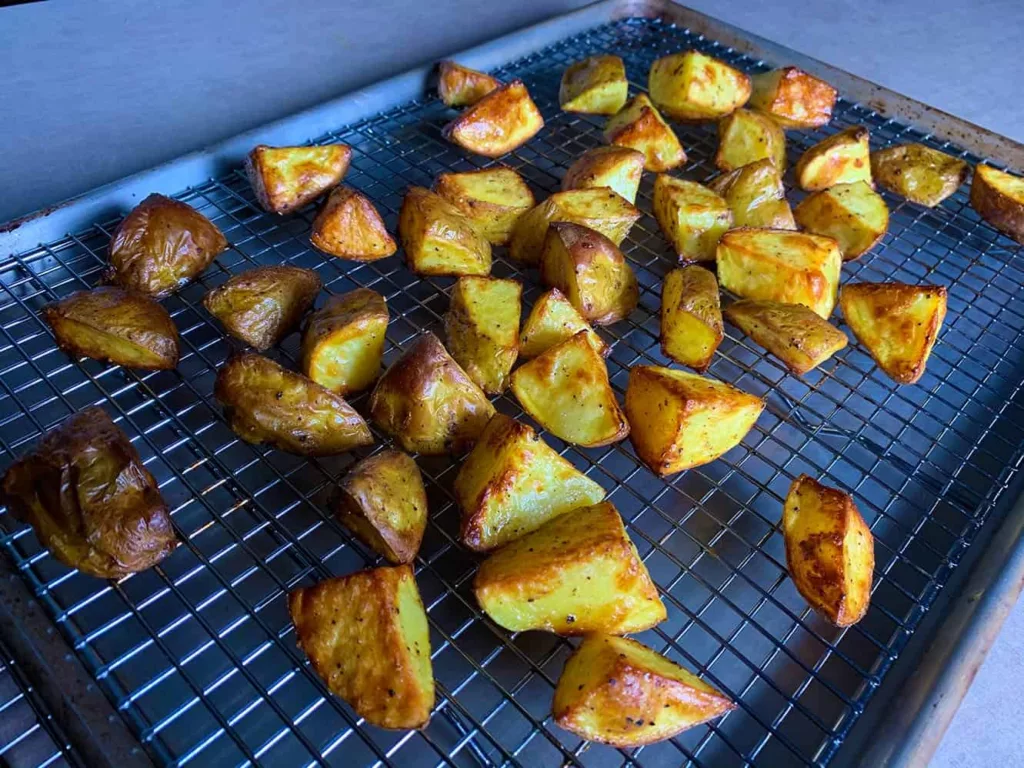
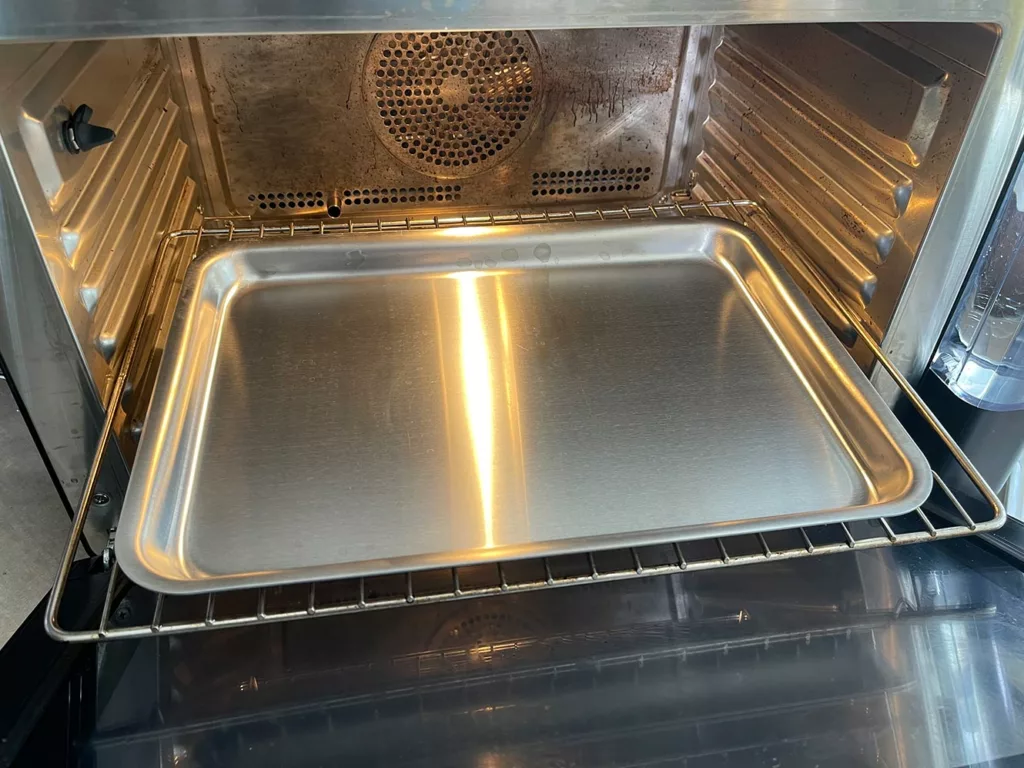


Nice review and article, thank you! As it happens I also started with the same Cuisinart oven a few years ago for the same reasons. The Anova is far and away better in most respects, but the Cuisinart is still better at being a toaster oven, so I’ll hang on to both for now.
Anova and Baking Steel recently released a steel made specifically for this oven – I just received mine and have thus far only used it for frozen pizza, but I’ll be using it for my own bread and pizza shortly. You can order it from either company’s website.
I’ve never had to empty the drip tray, just take it off once in a while to clean it. In my case the drip tray works as it’s supposed to on a refrigerator, i.e. the water evaporates before it needs to be emptied. I assume this depends on how often you use the steam function though.
I solved the counter space issue by putting mine on a microwave cart, where it fits nicely. Won’t solve the space issue for everyone but works in my kitchen. I have two different carts from IKEA and it fits very well on either.
Finally I wanted to point out that the first Anova oven I received was defective – if you preheated it to say 400F and then opened the door and closed it again, the oven would keep heating back up past the set temperature until it blew a breaker. Anova customer support was very responsive, and once I sent them a video of the problem they replaced it promptly. Just wanted to let your readers know that if you run into any issues with the oven they’re not necessarily going to be addressed with a firmware update. I had no problem getting it swapped out for a perfectly functioning unit, but hang on to the packaging until you’re sure there are no manufacturing issues with yours.
Have you baked any bread with it?
I’ve been dreaming of a steam injection oven for years.
If I could have a custom-sized baking steel made for this oven, it feels like it would be the best baguette oven ever.
Absolutely. Have you checked out the baking steel mini griddle?
It’s sized 11.5″x11.5″ so it will fit in the oven; albeit, with lots of length not taken advantage of. 3/8″ thick too, so lots of thermal capacity.
Can you set the amount of steam you want and the duration of steaming during baking? Or is more an on/off feature?
I sent a quote request for a custom 16x12x0.5″ seasoned baking steel to a local retailer.
I’m getting excited.
You can set the percentage of humidity from 0%-100% right on the machine (I think in increments of 5%, but don’t quote me on it, I don’t have the machine handy and I’m going off memory).
If you use the phone app, you can program a staged cook where the percentage changes (along with temperature, if you wish) at staged intervals during the cook.
Hi, I enjoyed reading your review and all the comments here. I’m undecided about whether to get the Anova or the Breville Smart Oven Air With Super Convection. My friend has the latter and absolutely loves it. The only thing the Anova can do that the Breville can’t is the ability to steam or sous vide. But I have a big asian layered steamer and a sous vide already. But I also make bread so the idea of not having to put a tray or water and/or spray water inside a hot oven seems appealing. So if you have to choose between the two, which one would you get? Thanks
Overall the Anova Oven wins out for me because of it’s Combi-oven functions. I too own a sous vide setup, but I find a combi oven much more convenient because there is no large container of water to dump at the end and it’s always ready to go (water tank lasts a long time). Also it’s much more convenient to “sous vide” without bags.
That being said, the Breville Smart Oven Air has a much more solid build quality. It’s also much easier to clean (it has a nonstick coating applied to the walls of the oven). If the added steam/sous vide function of the Anova Oven isn’t much value to you, the Breville Smart Oven Air is a solid choice.
Hi – have you tried using a dutch oven for a cook yet in the Anova? If so, how did it go? I saw a photo but don’t think I saw any sort of comment.
I have not actually cooked in it (just put it in to test the size); however, I’d imagine it would do just as well, if not a better job due to precise temperature control, as my other countertop oven. I’ve used a dutch oven in a Breville to simulate a slow cooker and have had great results.
hit combi oven is practically the size of a small regular oven. Wasn’t the point of countertop/toaster ovens their small size and thus faster heating and energy efficiency? Unfortunately this Anova oven can’t be built into the counters like regular ovens, yet is so big it takes up significant countertop space. Thus one MAJOR improvement would be the ability to build this into the counters like regular ovens.
I would say the cavity size is comparable to larger counter top ovens on the market, just more height. It would be nice to be able to build into the counter space; yes. There are options on the market for that (Miele and Thermador) but they are considerably more pricey than the Anova. I will consider adding one of them to my kitchen when I buy a new house in a few years.
Sorry, one more quick question for Tyler: Can you say a bit more about the spatchcocked chicken you cooked in the precision oven? You say it was different from a traditionally roasted chicken, and that while you can’t say you liked it more, if I’m understanding you correctly, you liked it equally, but as a different dish/product from traditionally roasted chicken. What made it different? Texture? Taste? Thank you!
The chicken is very moist. When you cut into it, a large amount of juices of the chicken is trapped in between the meat and the skin and it comes pouring out. A lot of the juice is retained within the chicken, even in the breast meat. The texture is also a little bit different.
The reason why I say they are like two different dishes is because I’ve grown accustomed to traditionally roasted chicken. Having moist chicken breast was a shock, and I started to think that maybe I have a preference for something dryer. Growing up, I’d have chicken dinner every Sunday with my grandmother and it brings back fond memories. The chicken cooked in the Anova did not bring back those memories… so it may have been a bit emotional too. That’s not to say I didn’t enjoy it…. it was just different.
Great review! I have a question that may not have a good practical answer… but here goes: I’ve been cooking sous vide for many years… made my first sous vide outfit 15+ years ago out of a livestock bucket heater and a PID temperature controller with a probe. Now own 3 sous vide outfits, an older PolyScience, a Joule, and a Sous Vide Supreme water oven. I also have the Cuisinart Steam Oven… bought it several years ago, but truthfully, have ended up only using it as a toaster oven, i.e. to make toast and bake smaller things. I’m pretty familiar with Combi ovens from a “reading/research” standpoint.
I’ve been thinking seriously about getting the Breville Control Freak. I’ve also looked at this Anova Precision Oven. If one couldn’t spring for both at the same time, which one would you buy first? I understand that there’s probably a lot of “it depends” in any potential answer, but just wondering what anyone might have to offer on which one you use most and why? Thank you!
Hi Keith,
This is an easy question for me… it would hands down be the Control Freak. Not sure if you read my review, but I own two of them: https://www.sizzleandsear.com/equipment-reviews/review-breville-polyscience-control-freak-induction-cooker/ (looks like it’s $200 off right now with delayed shipping — first time I’ve seen it on sale on Amazon)
Overall, it’s much better built and more precise than the oven. Of course, the oven has different applications that are better suited to it, but I find the versatility of the control freak makes it something that I use everyday. It’s also really intuitive to use, whereas the oven can be a bit fit finicky and for some functions require an app.
I also am a cook who enjoys stovetop cooking much more than oven cooking. I like being somewhat involved in the process; but the control freak does allow me to walk away pretty easily and do other things (I’ve made caramel sauce where I’ve left the kitchen for 5 minutes and came back).
I also like the fact that I can easily clear it out of the way to save counter space, whereas the oven is a more permanent fixture.
Both are great tools but the Control Freak is better suited to my needs. It may be different for someone else though.
LOL! I read your review about three times! I really appreciate it… I was thinking that the Control Freak might be the way to go. I, too, am pretty pleased with my current roasted chicken, and I have more than enough sous vide equipment. I suspect that one day I’ll also have the Precision Oven. But my other project right now is moving to a new home, and I’m having a high powered through the roof stove hood installed… so that plus the control freak will definitely stretch my kitchen budget pretty thin for the moment. One of the things I’m really looking forward to with the CF is the ability to deep fry things more easily, like sous vide fried chicken as shown on ChefSteps.
The list of temps for the CF is really helpful. I look forward to more recipes that make good use of this new technology, just as it took a while for sous vide recipes to become widely available when I was first starting out doing that years ago. One quick question (and I don’t mean to be a pest): On that list, there is a temp for scallops, but it also specifies “stir fried.” That makes more sense to me for, say, shrimp, but for sea scallops I just sit them in the skillet and don’t move them until they need turning… Same temp?
Oh, one more question: I have some really nice copper cookware, which I know won’t work on the CF. What sort of metal plate might you recommend that could sit on the CF between it and the copper pot? Is that doable?
All the best,
Keith
Good eye! Didn’t mean to have the scallops listed as stir fried. I’ve updated the list with the technique I use to cook scallops; have a look.
All my pans are induction-compatible. There are induction plates on the market to facilitate non-induction pans, but I haven’t used them so I can’t comment on them.
Hope you enjoy your Control Freak 🙂
Specifications. Dimensions please
Exterior (W,D,H):
22.4 x 17.7 x 14.1 in
Interior (W,D,H):
16.9 x 12.4 x 10in
Capacity: 1.2 cubic ft
Just got mine and baked some sour dough into. Wonderful! Lots of oven spring. It’s been fun tinkering around with it
I’ve been using combiovens for years in a professional kitchen. It would be great to have one at home! They are really versatile.
I’m brand new to this kind of cooking. Wish I knew it about it sooner.